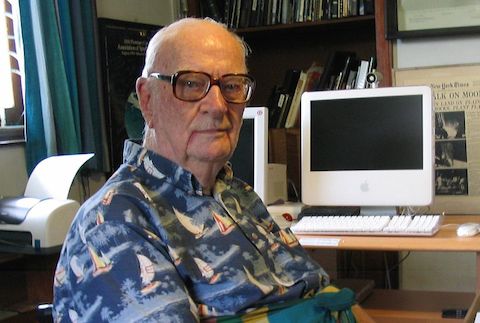
“Clarke sm” by Amy Marash. Licensed under Public Domain via Wikimedia Commons
When you want a vision of the future, I very much doubt you turn to Reader’s Digest for it. But Arthur C. Clarke did once appear in its small-format pages to provide just that, and when Arthur C. Clarke talks about the future, you’d do well to listen. Last year, we featured a 1964 BBC documentary in which the science-fiction luminary predicted the internet, 3D printers, and trained monkey servants. Today, we’d like to link you up to his Reader’s Digest predictions from the comparatively recent year of 2001 — one in which, for obvious reasons, Clarke made the media rounds — which you can read in full at arthurcclarke.net. Some highlights of his speculative timeline from 2001 to 2100:
- By 2010, commercial nuclear devices, household quantum generators, and fully re-engineered automobile engines will have ended the Fossil Fuel Age. We’ll have seen the first acknowledged human clone and seen off the last human criminal.
- By 2020, we’ll have discovered a 76-meter octopus, fly on “aerospace-planes” (one of which will carry Prince Harry), and trade in “mega-watt-hours” instead of any now-known currencies, and tsunamis caused by a meteor will wreck the coasts of Greenland and Canada (prompting the development of new meteor-detecting technologies).
- By 2030, artificial intelligence will have reached human level, we’ll have landed on Mars, computer-generated DNA will make possible a real-life Jurassic Park, and the neurological “braincap” will allow us the direct sensory experience of anything at all.
- By 2040, the “universal replicator” will allow us to create any object at all in the comfort of our own homes, resulting in the phase-out of work and a boom in arts, entertainment, and education.
- By 2050, Buckminster Fuller-style self-contained mobile homes become a reality, and humans scattered as far as “Earth, the Moon, Mars, Europa, Ganymede and Titan, and in orbit around Venus, Neptune and Pluto” celebrate the centenary of Sputnik 1.
- By 2090, Halley’s comet will have returned, and on it we’ll have found life forms that vindicate “Wickramasinghe and Hoyle’s century-old hypothesis that life exists through space.” We’ll also start burning fossil fuels again, both as a replacement for the carbon dioxide we’ve “mined” from the air and to forestall the next Ice Age by warming the globe back up a bit.
- By 2100, we’ll have replaced rockets with a “space drive” that lets us travel close to the speed of light. And so, Clarke writes, “history begins…”
You’ll notice, of course, that we’re already behind Clarke’s vision, according to which many a still-improbable development also lies ahead in the near future. In any case, though, the end of crime, the beginning of private space travel, and the era of the Dymaxion home must come sooner or later, mustn’t they? And as Clarke himself admits, one plays a mug’s game when one predicts, even when one does it with uncommon astuteness. “In 1971 I predicted the first Mars Landing in 1994,” he remembers in the preamble to his list. “On the other hand, I thought I was being wildly optimistic in 1951 by suggesting a mission to the moon in 1978. Neil Armstrong and Buzz Aldrin beat me by almost a decade.”
But to this day, Clarke’s scorecard looks better than most of ours: “I take pride in the fact that communications satellites are placed exactly where I suggested in 1945, and the name “Clarke Orbit” is often used (if only because it’s easier to say than ‘geostationary orbit’).” Who knows what he could tell us to watch out for now if, as he predicted in 2001, he’d lived to see his hundredth birthday aboard the Hilton Orbiter Hotel?
Related Content:
Arthur C. Clarke Narrates Film on Mandelbrot’s Fractals; David Gilmour Provides the Soundtrack
Isaac Asimov Predicts in 1964 What the World Will Look Like Today — in 2014
Free Science Fiction Classics on the Web: Huxley, Orwell, Asimov, Gaiman & Beyond
Colin Marshall hosts and produces Notebook on Cities and Culture as well as the video series The City in Cinema and writes essays on cities, language, Asia, and men’s style. He’s at work on a book about Los Angeles, A Los Angeles Primer. Follow him on Twitter at @colinmarshall or on Facebook.


Leave a Reply